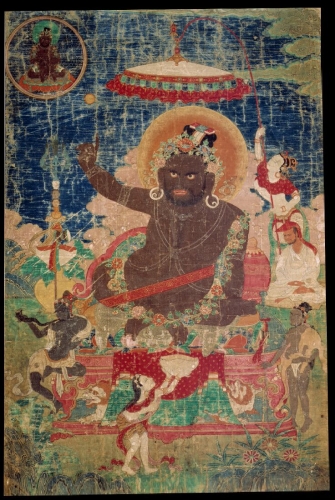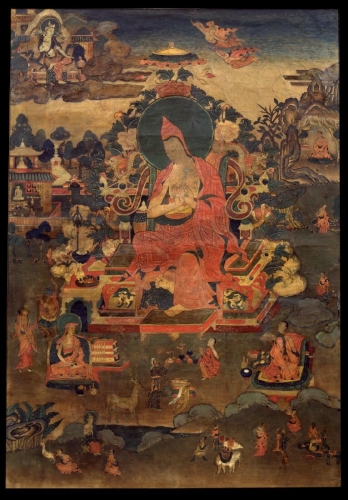Buddhist practice and Buddhist art have been inseparable in the Himalayas ever since Buddhism arrived to the region in the eighth century. But for the casual observer it can be difficult to make sense of the complex iconography. Not to worry—Himalayan art scholar Jeff Watt is here to help. In this “Himalayan Buddhist Art 101” series, Jeff is making sense of this rich artistic tradition by presenting weekly images from the Himalayan Art Resources archives and explaining their roles in the Buddhist tradition.
This week Jeff examines life story paintings & literary genre.
Himalayan Buddhist Art 101: Life Story Paintings & Literary Genre
Buddhist literature is overflowing with narratives about Shakyamuni, his followers, and of almost every possible human situation. The code of ethics for the monks and nuns, the Vinaya, is framed in narrative. When reading the life stories of historical figures such as Asanga, the mahasiddha Virupa, or the Tibetan teacher Tsongkapa, intention and intended audience are not always clear to the novice reader. Well, it is exactly the same when looking at life story paintings.
 Buddhist art transforms these literary narratives and visually creates a representation based on written examples, sometimes the representations are even based on oral tradition. The written examples are drawn from various established genres of traditional narrative literature. There are at least ten genres of life writing that are quite distinct. Alongside the old standards of biography and autobiography there are, for example, hagiography, secret biography, and revealed treasures. Each of these genres has a particular point of view, intention, and audience. These literary genres map directly from literature to art.
Buddhist art transforms these literary narratives and visually creates a representation based on written examples, sometimes the representations are even based on oral tradition. The written examples are drawn from various established genres of traditional narrative literature. There are at least ten genres of life writing that are quite distinct. Alongside the old standards of biography and autobiography there are, for example, hagiography, secret biography, and revealed treasures. Each of these genres has a particular point of view, intention, and audience. These literary genres map directly from literature to art.
The first example, a painting of the Virupa, fits the genre of a specific life event. In this case it is a moment in the life of the Tibetan teacher Sachen Kunga Nyingpo, when Sachen had a vision of the mahasiddha Virupa appearing in the sky surrounded by very specific attendant siddha figures. Sachen is not depicted in the painting, only the vision. The painting does not belong to a set of paintings. It is a one-off meant to depict a special moment in Sachen’s life.
 The second example is also narrating a life event genre story. This image of Arya Asanga highlights a series of episodes in Asanga’s spiritual life, which ultimately led to his having a direct communication with the Bodhisattva Maitreya. The result of this meeting between Maitreya and Asanga led to the writing of the famous philosophical texts of Asanga, although the texts are sometimes ascribed to Maitreya.
The second example is also narrating a life event genre story. This image of Arya Asanga highlights a series of episodes in Asanga’s spiritual life, which ultimately led to his having a direct communication with the Bodhisattva Maitreya. The result of this meeting between Maitreya and Asanga led to the writing of the famous philosophical texts of Asanga, although the texts are sometimes ascribed to Maitreya.
The third example is a painting of Je Tsongkapa surrounded by  nearly 100 separate vignettes narrating his entire life story in great detail. Each vignette is accompanied by an explanatory inscription written beneath the scene. This painting follows a very straightforward biography style literary genre.
nearly 100 separate vignettes narrating his entire life story in great detail. Each vignette is accompanied by an explanatory inscription written beneath the scene. This painting follows a very straightforward biography style literary genre.
Life story and narrative paintings are a popular topic in Himalayan and Tibetan art. While it is not really necessary to understand literary genre in order to appreciate the beauty and aesthetics of narrative art, it is helpful to know that the relationship between narrative literature and art is a very important and popular subject in Tibetan Buddhism.
To learn more about life story paintings click here. To learn more about literary genre click here.